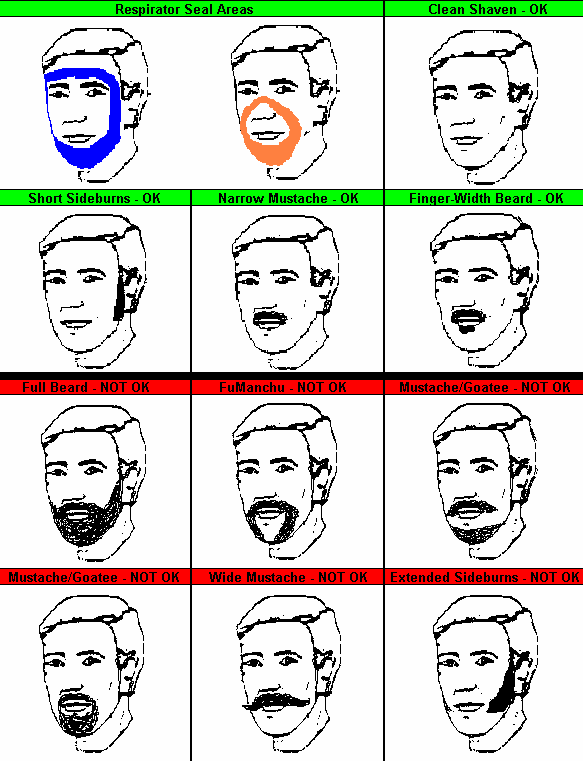There are some things that simply don’t go together. Oil and water. Polka dot and stripes. Facial hair and respirators. Facial hair prevents a protective facepiece from forming and/or maintaining a tight-fitting seal on someone’s face. It is important to achieve a tight fit for two reasons. First, an appropriately tight fit prevents any hazardous airborne material from entering the employee’s airway. Second, being clean-shaven is not only about safety, it keeps employers in compliance with OSHA’s Respiratory Protection Standard, particularly 1910.134(g)(1)(i)(A).
What OSHA has to say about facial hair
As stated in OSHA standard 29 CFR 1910.134(g)(1)(i)(A), employers “shall not permit respirators with tight-fitting face-pieces to be worn by employees who have facial hair that comes between the sealing surface of the face-piece and the face or that interferes with valve function.” This includes stubble or light beard growth.
Acceptable and Unacceptable facial hair
When it comes to wearing a respirator, there is little to no leeway for facial hair. While many men favor wearing facial hair, beards do not allow for a proper respirator fit. While there are a very small number of acceptable types of facial hair, most of the popular styles are prohibited. It is best for all employees who wear respiratory protection to remain clean-shaven on the job.
In fact, the only facial hair acceptable are small, neatly trimmed mustaches or beards bordering only the mouth of the employee. All facial hair under the chin or cheeks is prohibited for respirator wearing use. That includes small, neat beards or goatees that fit within a respirator.
Beard hair can render a respirator nearly useless. Without a solid fit, the respirator cannot protect against gases, particles and other unwanted airborne materials that can enter an employee's mouth and nose.
See the diagram below from NIOSH to use as a guide for your employees.

Remain clean-shaven at all times
When Examinetics technicians visit client worksites, they too often encounter employees who only shave for the fit test. Before and after the fit test, mustaches and beards are grown to any amount of length.
This cannot be overstated: while on the job that requires a tight-fitting respirator, you must be appropriately clean-shaven at all times. Your employee's beard should be no longer on fit testing day than any other day of the year.
If you’re uncertain about how to adequately protect your employees while also trying to maintain compliance with the OSHA Respiratory Protection Standard, you’re not alone. Examinetics is here to help. We will partner with you to protect the safety of your employees, and assist you to achieve complete compliance, including a written respiratory protection plan, employee training, medical clearance and fit testing.
Options for bearded employees
There may be options for some bearded employees who don’t want to shave, based on the resources and respiratory protection plan on your worksite. While a clean-shaven face is required for tight-fitting facepieces, a bearded employee may be able to use a hooded respirator like a Powered Air-Purifying Respirators (PAPR). Most PAPRs allow for all types of facial hair while allowing the employee to breathe easily and remain safe on the job. However, PAPRs are not sufficient protection for many hazards. A comprehensive hazard analysis is key in determining if any alternative options are allowable.
Ultimately, if an employee does not want to shave their face, then the safety manager and human resources should work with that employee to find a suitable position that does not require respiratory protection. OSHA allows employers to remove employees from positions requiring respiratory protection if all fit testing and user conditions are not met.
How Examinetics can help
Examinetics wants to help you keep your workforce safe and keep you in compliance. As such, our team of medical experts and nurses are prepared to help guide you through questions regarding facial hair, respirators and fit testing. This can be a significant point of contention for employees and leaves employers challenged to find ways to stay in compliance. We would be happy to assist you in any way that we can so that you and your workforce will be set up for not only a successful fit testing day but a successful every day.
---
This is business-to-business information intended for EHS (environmental health and safety) professionals and not intended for the final consumer. Companies should check the local regulatory status of any claim according to their individual needs, requirements and intended use.

